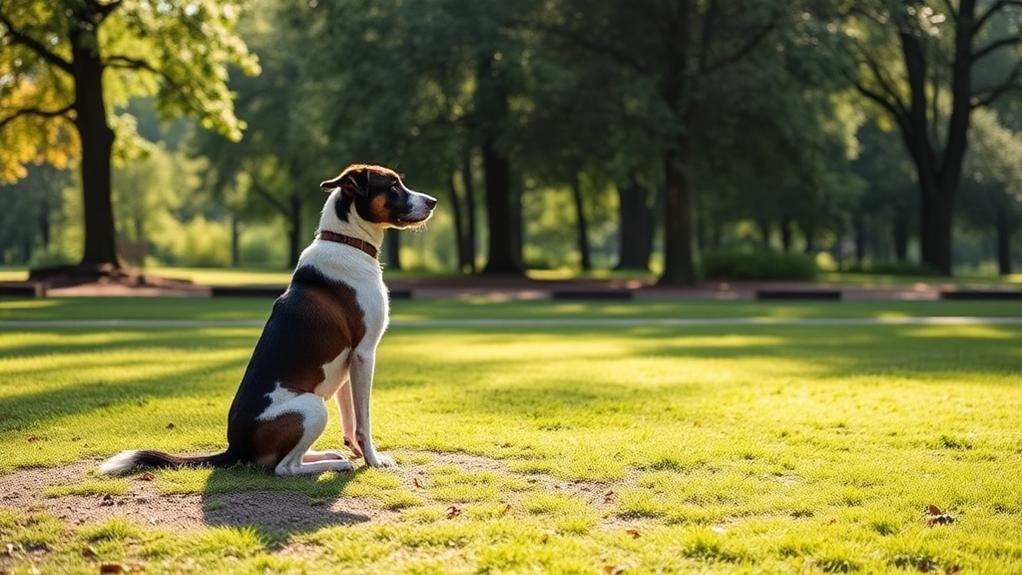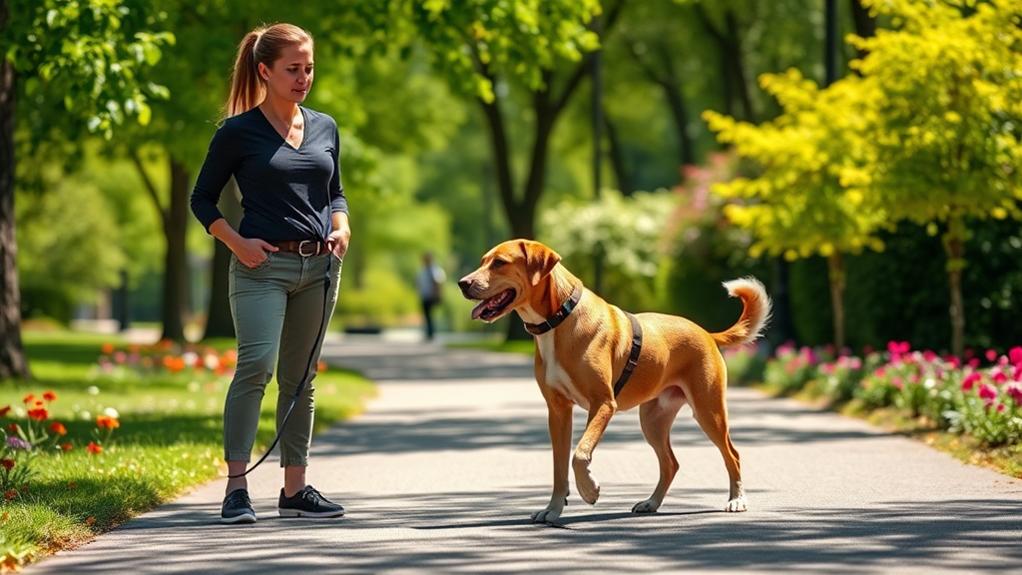Training your dog to understand basic commands like "Sit," "Stay," and "Come" is vital. Start by building trust and creating a positive atmosphere with treats and praise. Use clear, consistent cues, and reward immediately when your dog responds correctly. For "Sit," lure your dog into position with a treat. For "Stay," begin with a firm command while they're sitting, gradually increasing distance. Encourage engagement with a cheerful tone for "Come." Always maintain patience and adapt to your dog's pace. Stick with it, and you'll see progress. The next steps will reveal more effective strategies to enhance your training sessions.
Understanding Dog Training Basics
When you begin training your dog, it is indispensable to understand the basics that lay the foundation for a successful relationship. Start by building trust; your dog needs to feel secure and confident in you as a leader. Establishing a positive atmosphere during training sessions is crucial. Use treats, praise, and affection to reinforce good behavior.
Next, focus on consistency. Dogs thrive on routine, so use the same commands and cues every time. This will help your dog learn faster and avoid confusion. Timing is also important; reward your dog immediately after they perform the desired behavior to create a clear connection.
Patience is key in dog training. Every dog learns at their own pace, so don't rush the process. If your dog struggles to grasp a command, break it down into smaller steps and practice each part separately. Keep training sessions short and engaging, as dogs have limited attention spans.
Lastly, remember that socialization is a pivotal aspect of training. Expose your dog to various environments, people, and other animals to develop their confidence and adaptability. By focusing on these basics, you'll set your dog up for a lifetime of good behavior and companionship.
Essential Training Tools

A well-equipped trainer makes all the difference in successful dog training. You'll want to gather a few essential tools to make your training sessions efficient and enjoyable. First, invest in a sturdy leash and collar or harness. A 6-foot leash offers flexibility while keeping your dog safe and under control. Choose a collar that fits well and is comfortable for your pup.
Next, consider using training treats. Small, soft treats are perfect for rewarding good behavior and keeping your dog motivated. Make sure to select treats your dog loves, as this will encourage them to focus on learning.
Additionally, a clicker can be a valuable tool in your training arsenal. It provides a clear signal that your dog has done something right, helping them associate the behavior with the reward.
Teaching the "Sit" Command
Teaching your dog the "Sit" command is one of the most fundamental skills you can instill, and it's often the first command every dog learns. This command sets the foundation for good behavior and helps establish a clear line of communication between you and your furry friend.
To begin, gather some tasty treats to motivate your dog. Start in a quiet space with minimal distractions. Hold a treat just above your dog's nose and slowly move it toward the back of their head. As your dog follows the treat, their rear end will naturally lower to the ground. The moment their bottom touches the floor, say "Sit" and give them the treat along with plenty of praise.
Repeat this process several times, ensuring your dog associates the action with the command. Be patient; it might take a few tries for them to grasp it fully. Practice daily, gradually reducing the use of treats as your dog becomes more reliable. If they struggle, go back to the basics and try again. Consistency is key, so keep training sessions short and positive. Before long, your dog will willingly sit on command!
Mastering the "Stay" Command

The "Stay" command is essential for keeping your dog safe and well-behaved in various situations. To start, have your dog in a sit position. Stand in front of them and firmly say "Stay" while showing your palm as a visual cue. It's important to maintain a calm and assertive demeanor.
Once your dog's in position, take a small step back. If they remain put, praise them immediately and give a treat. If they move, gently guide them back to the original spot and repeat the command. Consistency is key, so practice this several times, gradually increasing the distance you step back.
Next, introduce distractions. Have someone walk by or drop an object to see if your dog stays put. If they remain in position, reward them generously. If not, go back to the previous step until they understand the command under less distracting conditions.
Always end training sessions on a positive note. Praise your dog for their efforts and keep sessions short—about 5 to 10 minutes—so they stay engaged. With patience and practice, your dog will master the "Stay" command, enhancing their safety and manners.
Learning the "Come" Command

Once your dog understands the "Stay" command, it's time to focus on the "Come" command, which is pivotal for recall in any situation. Start in a quiet area with minimal distractions. Use a cheerful tone, and invite your dog by saying "Come!" while gently backing away. This encourages them to move toward you.
When your dog approaches, praise them enthusiastically. Rewarding them with treats or affection reinforces positive behavior. If they don't come right away, don't panic. You can try using a favorite toy or treat to entice them. It's essential not to call them in a harsh tone, as this can create a negative association.
Practice this command frequently, gradually increasing the distance between you and your dog. Once they consistently respond in a controlled environment, try it in more distracting settings, like your backyard or a park. Remember, patience and consistency are key. Always celebrate their success, no matter how small. This builds their confidence and strengthens your bond. With time and practice, your dog will learn to come to you reliably, ensuring their safety and your peace of mind.
Practicing the "Heel" Command

Practicing the "Heel" command is essential for maintaining control during walks and ensuring your dog stays close by your side. Start by choosing a quiet area with minimal distractions, like your backyard or a park. Equip yourself with treats and your dog's favorite leash.
Begin by standing still with your dog at your left side. Use a treat to lure your dog into the correct position, ensuring they're focused on you. Say "Heel" clearly and take a few steps forward, encouraging your dog to follow. If they lag behind or pull ahead, gently guide them back to your side with the leash.
Practice walking at a comfortable pace, rewarding your dog with praise or a treat every few steps they stay in the correct position. Keep sessions short—about 5 to 10 minutes—to prevent your dog from losing interest. Always maintain a positive attitude, as your energy will influence your dog's behavior.
As your dog becomes more proficient, try practicing in different environments with more distractions. This helps reinforce their learning and builds their confidence. With consistent practice, your dog will master the "Heel" command, making walks more enjoyable for both of you.
Reinforcing Positive Behavior

Reinforcing positive behavior is indispensable for effective dog training and helps build a strong bond between you and your furry friend. When you reward your dog for good behavior, you encourage them to repeat those actions. This approach creates a happy learning environment and fosters trust between you both.
Use treats: Offer small, tasty treats immediately after your dog performs the desired action. Timing is pivotal, so make sure to reward them right away.
Praise verbally: Use a cheerful tone and words like "good boy" or "great job" to let your dog know they've done well. Your enthusiasm will motivate them!
Incorporate playtime: If your dog loves to play, use their favorite toy or game as a reward. This not only reinforces behavior but also makes training enjoyable.
Be consistent: Always reward the same behaviors to help your dog understand what you expect. Consistency is imperative to effective training.
Common Training Challenges

While rewarding positive behavior lays a solid foundation for training, you may encounter challenges that can hinder your progress. One common issue is inconsistency; if you don't apply commands uniformly, your dog might get confused. Make sure everyone in your household uses the same commands and rewards.
Another challenge is distractions. Dogs are naturally curious, and outside stimuli can divert their attention. Start training in a quiet environment, then gradually introduce distractions to help your dog focus amid chaos.
You might also face stubbornness. Some dogs simply don't want to obey. Patience is vital. Instead of forcing compliance, try to make the training engaging and fun. Use treats or toys as incentives to motivate your pup.
Lastly, timing is pivotal. If you delay rewards or corrections, your dog won't connect the action with the outcome. Always reward immediately after a positive behavior or redirect promptly when they misbehave.
Conclusion
By following this step-by-step guide, you're well on your way to establishing a solid foundation of commands with your dog. Remember to be patient and consistent, using positive reinforcement to encourage good behavior. Every dog learns at its own pace, so celebrate small victories along the way. With practice and dedication, you'll strengthen your bond and guarantee your furry friend becomes a well-mannered companion. Enjoy the journey of training together!



